Senate (Netherlands)
The Senate (Dutch: Eerste Kamer der Staten-Generaal [ˈeːrstə ˈkaːmər dɛr ˈstaːtə(n) ˌɣeːnəˈraːl] or simply Eerste Kamer [ˈeːrstə ˈkaːmər] (![]() listen), literally "First Chamber", or sometimes Senaat [səˈnaːt]) is the upper house of the States General, the legislature of the Netherlands. Its 75 members are elected on lists by the members of the twelve States-Provincial and three Caribbean electoral colleges for the Senate every four years, within three months of the provincial elections. All provinces and colleges have different electoral weight depending on their population.
listen), literally "First Chamber", or sometimes Senaat [səˈnaːt]) is the upper house of the States General, the legislature of the Netherlands. Its 75 members are elected on lists by the members of the twelve States-Provincial and three Caribbean electoral colleges for the Senate every four years, within three months of the provincial elections. All provinces and colleges have different electoral weight depending on their population.
Senate Eerste Kamer der Staten-Generaal | |
|---|---|
| States General of the Netherlands | |
 | |
| Type | |
| Type | |
| Leadership | |
First Vice President | |
Second Vice President | |
| Structure | |
| Seats | 75 |
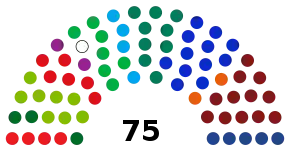 | |
Political groups | Government (32)
Opposition (43)
|
Length of term | 4 years |
| Elections | |
| Indirect party-list proportional | |
Last election | 27 May 2019[1] |
Next election | 2023 |
| Meeting place | |
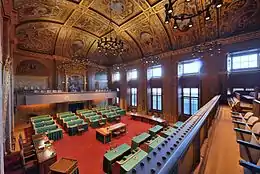 | |
| Senate Chamber, Binnenhof, The Hague | |
| Website | |
| www | |
Members of the Senate are part-timers who often hold other positions as well. They receive an allowance which is about a quarter of the salary of the members of the lower house. Unlike the politically more significant House of Representatives, it meets only once a week. Its members tend to be veteran politicians or part-time politicians at the national level, often having other roles.
It has the right to accept or reject legislative proposals but not to amend them or to initiate legislation. Directly after a bill has been passed by the House of Representatives, it is sent to the Senate and is submitted to a parliamentary committee. The committee decides whether the bill can be immediately put on the agenda of the full chamber or there should first be preparatory study of the bill. If a bill is immediately put on the agenda of the full chamber, it is passed as a formality without a debate.
Name
Although this body is called the "Senate" in English, this is not a direct translation of its official Dutch name, the "First Chamber of the States General" or, in short, the "First Chamber". Nevertheless, and in contrast to the Second Chamber, the name Senaat is also used often in the media. "Member of the First Chamber" (Eerste Kamerlid), "member of the Senate" (senaatslid) or "senator" (senator) are used, although the first one is the official and most used term.
History
The first constitution of the modern Netherlands, passed in 1814, re-established a unicameral States General. As it became clear that the former Southern Netherlands would be added to the new United Kingdom of the Netherlands, a newly instituted constitutional commission was tasked with drafting a new constitution. The southern members of the constitutional commission pressed for a bicameral system because of the conviction that their nobility should be given a place in the legislature. While the northern members were not enthusiastic about the proposal, they agreed under the condition that nobility would not be a requirement for membership.[2][3] The new constitution, which came into effect on 24 August 1815, thus provided for a Senate consisting of forty to sixty members appointed by the king for life. The list of the first appointees was published on 16 September 1815 and the newly appointed chamber was first assembled on 21 September 1815 in Brussels in a joint assembly with the House of Representatives.[4] In its early years, the Senate functioned as a bulwark of the Crown (the king and his ministers). Its members, appointed by the king from among the "most significant of the country", were mostly confidants of the king who were often called upon to veto bills that displeased him. Such bills were usually private members' bills from the House of Representatives.[2] The Senate remained in existence after the separation from Belgium in 1830, although its membership was halved to no fewer than twenty and no more than thirty members.[4]
Much changed in the political sphere as a result of the Constitutional Reform of 1848, which introduced direct elections for the House of Representatives, which until then had been elected by the States-Provincial. The constitutional commission, under the chairmanship of Johan Rudolph Thorbecke, intended for the Senate to be directly elected as well, but the predominantly conservative House of Representatives blocked this, fearing that the two chambers would be too similar. Additionally, Senators were expected to judge bills with more independence and distance from daily politics, as a "chambre de reflection", which was deemed impossible when they would be forced to campaign for direct election.
It was therefore decided that the Senate would henceforth be elected by the States-Provincial. Its 39 seats were distributed among the provinces degressively proportional to population, and a third of its members would be elected for 9-year terms every three years using a majoritarian system.[5] The position of the Senate and the criteria governing eligibility to stand for election were also among the changes. Monitoring the quality of legislation gradually came to be the main function of the Senate after 1848.[6]
The existence and functioning of the Senate have been criticised throughout history, manifested in reports of state commissions, government proposals and private bills calling for reform or abolition of the Senate. Abolition of the Senate was attempted by social democrats and progressive liberals in 1903, and again after World War I, but these proposals could not count on sufficient support.[2]
However, reform came in 1922, five years after a constitutional amendment that introduced universal male suffrage and proportional representation to the House of Representatives. The constitutional amendment of 1922 brought proportional representation to the Senate as well. Rather than the seats being distributed among the provinces, the provinces were now organised into four groups of roughly equal population, each electing twelve or thirteen Senators under party-list proportional representation. The term of Senators was decreased to six years, with two of the four groups electing their Senators every three years. The number of Senators was increased from 50 to 75 in 1956, and the distribution of seats among groups of provinces was adapted to account for changes in population distribution.[5]
The Senate was subjected to another reform in 1983. The term of Senators was further reduced to four years, equal to that of Representatives. The system of groups of provinces and staggered elections was abolished in favour of quadrennial elections for the entire Senate in one nationwide constituency. Several minor changes have since been adopted. In 2010, the possibility for party lists to enter into an electoral alliance was abolished, and the number of preference votes needed for a candidate to be elected was increased from 50% to 100% of the quota. Another amendment in 2017 enfranchised the island councils of Bonaire, Sint Eustatius and Saba, three public bodies within the Netherlands.[5]
.jpg.webp)
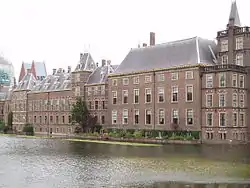
Parliamentary leaders
| Parliamentary leader | Party | Seats | Leader since | Member since | ||
|---|---|---|---|---|---|---|
.JPG.webp) |
Annemarie Jorritsma (born 1950) |
People's Party for Freedom and Democracy |
12 | 24 November 2015 (5 years, 71 days) |
9 June 2015 (5 years, 239 days) | |
.jpg.webp) |
Dr. Ben Knapen (born 1951) |
Christian Democratic Appeal |
9 | 11 June 2019 (1 year, 237 days) |
7 June 2011 (9 years, 241 days) | |
 |
Paul Rosenmöller (born 1956) |
GroenLinks | 8 | 11 June 2019 (1 year, 237 days) |
11 June 2019 (1 year, 237 days) | |
_(cropped).jpg.webp) |
Dr. Annelien Bredenoord (born 1979) |
Democrats 66 | 7 | 11 June 2019 (1 year, 237 days) |
24 January 2019 (2 years, 10 days) 9 June 2015 – 3 October 2018 (3 years, 110 days) | |
.jpg.webp) |
Dr. Mei Li Vos (born 1970) |
Labour Party | 6 | 11 June 2019 (1 year, 237 days) |
11 June 2019 (1 year, 237 days) | |
| Marjolein Faber (born 1960) |
Party for Freedom | 5 | 10 June 2014 (6 years, 238 days) |
7 June 2011 (9 years, 241 days) | ||
.JPG.webp) |
Tiny Kox (born 1953) |
Socialist Party | 4 | 10 June 2003 (17 years, 238 days) |
10 June 2003 (17 years, 238 days) | |
| Mirjam Bikker (born 1982) |
Christian Union | 4 | 11 June 2019 (1 year, 237 days) |
22 December 2016 (4 years, 43 days) 9 June 2015 – 1 September 2016 (1 year, 78 days) | ||
.jpg.webp) |
Niko Koffeman (born 1958) |
Party for the Animals |
3 | 12 June 2007 (13 years, 236 days) |
12 June 2007 (13 years, 236 days) | |
| Dr. Paul Frentrop (born 1954) |
Forum for Democracy |
2 | 1 September 2020 (155 days) |
11 June 2019 (1 year, 237 days) | ||
.jpg.webp) |
Martin van Rooijen (born 1942) |
50PLUS | 2 | 11 June 2019 (1 year, 237 days) |
11 June 2019 (1 year, 237 days) 9 June 2015 – 23 March 2017 (1 year, 281 days) | |
| Peter Schalk (born 1961) |
Reformed Political Party |
2 | 9 June 2015 (5 years, 239 days) |
9 June 2015 (5 years, 239 days) | ||
 |
Ton Raven (born 1957) |
Independent Senate Group |
1 | 19 January 2021 (15 days) |
19 January 2021 (15 days) | |
| Independents | ||||||
| Parliamentary leader | Group | Seats | Leader since | Member since | ||
| Bob van Pareren (born 1947) |
Fractie-Van Pareren (ex-FvD) |
7 | 30 November 2020 (65 days) |
11 June 2019 (1 year, 237 days) | ||
| Henk Otten (born 1967) |
Fractie-Otten (ex-FvD) |
3 | 25 July 2019 (1 year, 193 days) |
11 June 2019 (1 year, 237 days) | ||
Members of the Presidium
| President | Party | Service in the Presidium |
Service in the Senate | ||
|---|---|---|---|---|---|
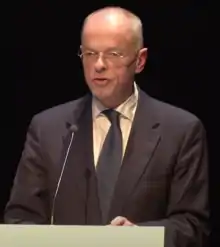 |
Dr. Jan Anthonie Bruijn (born 1958) |
People's Party for Freedom and Democracy |
2 July 2019 (1 year, 216 days) |
6 November 2012 (8 years, 89 days) | |
| First Deputy President | Party | Service in the Presidium |
Service in the Senate | ||
.jpg.webp) |
Jopie Nooren (born 1961) |
Labour Party | 9 July 2019 (1 year, 209 days) |
9 June 2015 (5 years, 239 days) | |
| Second Deputy President | Party | Service in the Presidium |
Service in the Senate | ||
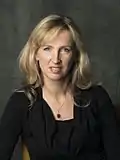 |
Arda Gerkens (born 1965) |
Socialist Party | 9 July 2019 (1 year, 209 days) |
14 May 2013 (7 years, 265 days) | |
Elections and membership
Electoral system
 |
|---|
| This article is part of a series on the politics and government of Netherlands |
The 75 Senators are elected every four years by the members of the States-Provincial of the country's twelve provinces. The seats are distributed in one nationwide constituency using party-list proportional representation. Remainder seats are distributed using the highest averages method. The weight of a member's vote is determined by the population of the province in which the voter is a member of the States-Provincial. The table below shows the weight of members' votes per province as of the 2019 election.[7]
| Province | Members | Population[8] | Value |
|---|---|---|---|
| South Holland | 55 | 3,674,146 | 668 |
| North Holland | 55 | 2,853,488 | 519 |
| North Brabant | 55 | 2,544,995 | 463 |
| Gelderland | 55 | 2,071,913 | 377 |
| Utrecht | 49 | 1,342,194 | 274 |
| Overijssel | 47 | 1,156,373 | 246 |
| Limburg | 47 | 1,116,127 | 237 |
| Friesland | 43 | 647,740 | 151 |
| Groningen | 43 | 584,094 | 136 |
| Drenthe | 41 | 492,179 | 120 |
| Flevoland | 41 | 416,431 | 102 |
| Zeeland | 39 | 383,073 | 98 |
| Bonaire | 9 | 20,104 | 22 |
| Sint Eustatius | 5 | 3,138 | 6 |
| Saba | 5 | 1,915 | 4 |
Historic composition
| Parties | Seats 2019 | Seats 2015 | Seats 2011 | Seats 2007 | Seats 2003 | Seats 1999 | Seats 1995 | Seats 1991 |
|---|---|---|---|---|---|---|---|---|
| Forum for Democracy (FvD) | 12 | |||||||
| People's Party for Freedom and Democracy (VVD) | 12 | 13 | 16 | 14 | 15 | 19 | 23 | 12 |
| Christian Democratic Appeal (CDA) | 9 | 12 | 11 | 21 | 23 | 20 | 19 | 27 |
| Democrats 66 (D66) | 7 | 10 | 5 | 2 | 3 | 4 | 7 | 12 |
| Party for Freedom (PVV) | 5 | 9 | 10 | |||||
| Socialist Party (SP) | 4 | 9 | 8 | 12 | 4 | 2 | 1 | |
| Labour Party (PvdA) | 6 | 8 | 14 | 14 | 19 | 15 | 14 | 16 |
| GreenLeft (GL) | 8 | 4 | 5 | 4 | 5 | 8 | 4 | 4 |
| Christian Union (CU) | 4 | 3 | 2 | 4 | 2 | 4 | 2* | 2* |
| Party for the Animals (PvdD) | 3 | 2 | 1 | 1 | ||||
| Political Reformed Party (SGP) | 2 | 2 | 1 | 2 | 2 | 2 | 2 | 2 |
| 50PLUS (50+) | 2 | 2 | 1 | |||||
| Independent Senate Group (OSF) | 1 | 1 | 1 | 1 | 1 | 1 | 1 | |
| Pim Fortuyn List (LPF) | 1 | |||||||
| General Elderly Alliance (AOV) | 2 | |||||||
| Total | 75 | 75 | 75 | 75 | 75 | 75 | 75 | 75 |
* Reformatory Political Federation (RPF) and Reformed Political League (GPV)
See also
- List of Presidents of the Senate (Netherlands)
Notes
- Elected for Forum for Democracy.
References
- "Dag van stemming (27 mei 2019)". Kiesraad.nl (in Dutch). Retrieved 21 September 2018.
- "Tweekamerstelsel". Parlement & Politiek (in Dutch). Retrieved 13 January 2018.
- "Geschiedenis Eerste Kamer". Eerste Kamer der Staten-Generaal (in Dutch). Retrieved 13 January 2018.
- "Eerste Kamer der Staten-Generaal (1815-1861)". Huygens Instituut (in Dutch). Retrieved 13 January 2018.
- "Geschiedenis kiesstelsel Eerste Kamer". Parlement & Politiek (in Dutch). Retrieved 13 January 2018.
- "English". Eerste Kamer. Retrieved 2 August 2014.
- "Eerste Kamer". Kiesraad.nl (in Dutch). Retrieved 5 October 2018.
- Population figures: 1 January 2019
External links
| Wikimedia Commons has media related to Eerste Kamer. |
- Official website (English)
- Official website (Dutch)